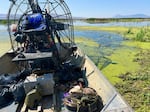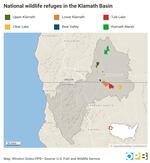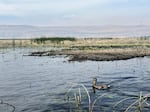
Dead birds collected during the suspected avian botulism and flu outbreak on the Klamath National Wildlife Refuge Complex in August 2024. Thousands of birds are estimated to have died so far this year.
Courtesy of Moss Driscoll via Klamath Water Users Association
A combination of botulism and bird flu has led to estimates of thousands of birds dying in the Klamath Basin National Wildlife Refuge Complex this summer.
Birds are dying at the Tule Lake National Wildlife Refuge in far Northern California. Last week, refuge staff deployed in a boat and collected 500 dead birds from Sump 1A, the largest water body in the Tule Lake Refuge.
John Vradenburg, supervisory biologist at the Klamath Basin National Wildlife Refuge Complex, suspects they’re dealing with a dual outbreak of botulism and highly pathogenic avian influenza, which was discovered in the refuges earlier this summer.
“We’re well-versed in botulism response,” says Vradenburg. “This is a new pressure we’ve never dealt with.”
Irrigators and waterfowl advocates are calling for managers at the U.S. Bureau of Reclamation to release water from Upper Klamath Lake and divert it to the refuges. Refuge staff are hoping the outbreak doesn’t escalate into a repeat of 2020, when 60,000 ducks, geese, and shorebirds died of botulism.
“Any of us that had been here in 2020 were like, ‘Oh my god; I don’t want to deal with this again,’” says Vradenburg.
Echoes of 2020 outbreak
A complex of six wildlife refuges spanning the Oregon-California border, the Klamath Basin National Wildlife Refuge Complex serves as vital feeding and breeding grounds for tens of thousands of birds that use the Pacific Flyway to migrate.
The Lower Klamath and Tule Lake Refuges have been teeming with ducks, geese, grebes, and shorebirds this year, thanks in part to a wet winter and a greater allocation of water to the Klamath Project, the management project developed by the Bureau of Reclamation to supply farmers in the Klamath Basin with irrigation water. In spring, the Bureau of Reclamation diverted additional water to the refuges to avoid creating unsafe conditions on the Klamath River while three dams are being removed in Southern Oregon and far Northern California.
“Compared to what we can tell from historic records, this is the highest and most diverse waterbird population we’ve had on Tule Lake in three or four decades,” says Vradenburg. He estimates there are about 30,000 nesting grebes on the large water body known as Sump 1A, and 250,000 molting birds and up to 60,000 ducklings on Sump 1A and Sump 1B combined.

National wildlife refuges in the Klamath Basin.
Winston Szeto / OPB
The refuges rely on allocations from the Klamath Project for water; during the recent drought years, they received virtually none.
Tule Lake in particular has transformed, says Moss Driscoll, director of water policy for the Klamath Water Users Association, or KWUA. “What had been a 14,000-acre patch of weeds turned right back into an incredible vibrant wetland.”
Related: No bird flu cases in Oregon cattle, although the state is taking precautions
But after the last water releases from Upper Klamath Lake in May, the wetlands in the refuges began to warm and dry out, heightening the risk for an outbreak of avian botulism.
The disease is caused by a toxin produced by a certain species of soil-dwelling bacteria. Birds become poisoned when they ingest infected fish, water, plant matter, or invertebrates. Infected birds experience nerve damage, weakness, and paralysis; often, they drown because they can’t hold their heads up. The disease spreads as birds feed on other maggot-infested bird carcasses.
The 2020 botulism outbreak was the worst in refuge history. The next summer, with the region still in the grips of a severe drought, a combination of luck and creative management helped avoid another disaster.
The key to preventing botulism “is not letting it get started,” says Driscoll. Wetlands that remain flooded with water circulating through them are less likely to experience an outbreak.
On July 12, KWUA sent the Bureau of Reclamation a letter, urging the agency to take action to avoid a disease outbreak on the refuges, and to increase water allocations to irrigators to save this year’s crop harvests.
Around that same time, refuge staff started spotting dead and dying eared grebes. All of the samples they collected tested positive for highly pathogenic avian influenza. This disease, also known as H5N1, has been ravaging wild and domestic birds across the globe. In the U.S., bird flu has spread to dairy cows, and there have been several confirmed cases of human infection.
The combination of bird carcasses, drying wetlands, and warm water created a “perfect storm” of conditions for botulism, says Vradenburg.

A mallard swims in one of the Klamath National Wildlife Refuges in August, 2024 during a botulism and avian flu outbreak.
Courtesy of Moss Driscoll via Klamath Water Users Association
Though it’s too late to prevent a botulism outbreak now, the damage could be minimized, say advocates. The Bird Alliance of Oregon (formerly Portland Audubon), California Waterfowl Association, and Ducks Unlimited have all called on the Bureau of Reclamation to divert water to the refuges immediately.
Vradenburg says that would help flush water through the system and cool temperatures. Perhaps most importantly, it would flood more wetlands, helping disperse birds across a greater area — an especially important strategy if the bird flu virus is still present.
In an Aug. 15 letter, KWUA called for “dynamic operations” to circulate water within and between the various wetlands in Tule Lake Refuge. The organization also urged the bureau to provide more water to the Lower Klamath Refuge to support the thousands of hatchlings there. Otherwise, the letter warned, this wetland could go dry before the birds have a chance to fledge.
The Bureau of Reclamation did not respond to JPR’s questions in time for publication.
Long-term solution needed
The bureau is tasked with managing flows to satisfy a number of obligations: providing irrigation water to farms in the Klamath Project; maintaining lake levels in Upper Klamath Lake to support endangered suckers (c’waam and koptu, which are vitally important to the Klamath Tribes); and ensuring flows in the Klamath River to support threatened coho salmon. During many years, there’s more demand for water than is available.
Spawning adult and young suckers rely on the wetlands along the shores of Upper Klamath Lake; when lake levels drop too low, they can no longer access them. In the past, the Klamath Tribes have expressed support for collaborative solutions that benefit the refuges, but not at the expense of suckers in Upper Klamath Lake. The Tribes also want to make sure there’s enough water to flood a massive 14,000-acre restoration project adjacent Upper Klamath Lake this fall without jeopardizing young suckers in the Upper Klamath Lake wetlands.
The volumes being discussed would lower the elevation of the 96-square-mile Upper Klamath Lake by no more than one-tenth of a foot, or a little over an inch, says Driscoll. He says the lake is currently about one foot above the end of season threshold required by the U.S. Fish and Wildlife Service’s analysis.
Related: US is ‘flying blind’ with bird flu, repeating mistakes of COVID, health experts say
In the long term, KWUA recommends flowing water from Upper Klamath Lake, through the refuge system, and back to the Klamath River as a way to mitigate future botulism outbreaks in the refuges while supporting agriculture and water quality for fish. Such a scenario would utilize pumping water between Tule Lake and Lower Klamath Refuge via a 4,000-foot tunnel through the base of Sheepy Ridge.
“You can run water all the way from Upper Klamath Lake all the way through the Klamath Project down into Tule Lake, pump it over to Lower Klamath, and send it back to the Klamath River,” says Driscoll.
This spring, the pump system known as “D Plant” was activated for the first time in four years, diverting water from the already full sumps in Tule Lake Refuge to the Lower Klamath.
Vradenburg says refuge staff and many others think this “flow-through” strategy could improve the health of a fragmented wetland ecosystem. “In the long term, if D Plant had the capacity to turn on, it could help flush the system,” he says.
In a response to KWUA’s July letter, Karl Stock, regional director for the California-Great Basin region at the Bureau of Reclamation, wrote that “‘flow through’ may have potential to improve project operations and ecosystem health in the future,” but that the proposal needed more analysis.

Ducks in flight in an undated photo at one of the Klamath National Wildlife Refuges.
Courtesy of Mary Hyde via USFWS
Avian flu complicates outbreak response
For the last two weeks, refuge staff have been surveying the wetlands and collecting dead birds. Vradenburg estimates at least 5,000 have died so far.
The likely presence of highly pathogenic avian influenza is complicating how they respond to the crisis. Unfortunately, this means staff can’t set up a rehab hospital to treat birds sickened with botulism, as they have in the past, because they can’t risk people coming into contact with the bird flu virus in a confined area. As it is, refuge staff are following heightened biosecurity protocols when they’re out in the field.
“This one’s tough for us; it’s not how we’d like to be doing it,” says Vradenburg. “But we can’t pivot to a new management action until we have results.”
Samples have been sent to the U.S. Geological Survey’s National Wildlife Health Center in Madison, Wisconsin, for analysis. At this time, all of the refuges are still open to the public.
Related: Migratory birds could cause avian influenza in Northwest dairy cattle
If there’s a silver lining, it’s that the outbreak has not yet spread beyond Sump 1A at Tule Lake, and numbers of sick and dead birds have not increased significantly from day to day.
Cooler temperatures and active management could be helping to dampen the outbreak. Refuge managers have been strategically dewatering smaller wetlands in the Lower Klamath Refuge to keep the largest one filled. Restoration work completed during the drought is helping water flow through parts of the Tule Lake Refuge, which could be helping keep botulism in check there.
Refuge staff are holding their collective breath, hoping the thousands of hatchlings and molting birds can weather the threat.
“The wetlands are extremely productive right now, and they should be even better next year as water quality continues to improve,” says Vradenburg. “There’s good stuff happening along with the bad stuff.”